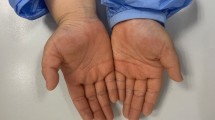Abstract
Contact dermatitis (CD) is a common itchy inflammatory skin disease. It is the most common skin disease in industrialized societies. In a recent study the incidence rates of CD was found to be 13.4 % and the point prevalence was found as 20.1 % (Mortz, Bindslev-Jensen and Andersen Br, J Dermatol 2013;168(2):318–25). There are two main types of CD: irritant contact dermatitis (ICD) and allergic contact dermatitis (ACD). Most cases are ICD (80 %). ICD is a non-immune non specific reaction caused by direct injury to the skin by strong irritants like: strong acids and alkalis. ACD is an immune mediated delayed type hypersensitivity reaction induced by many materials (allergens) like: metals, preservatives, perfumes, rubber, resins, dyes and many more. This type of CD appears only in patients that previously were sensitized to these materials (Ale and Maibacht, Expert Rev Clin Immunol 2010;6(2):291–310). Patch tests are used to identify the culprit allergens. In this article we will discuss the issues of contact dermatitis and patch testing in pregnancy.
Similar content being viewed by others
References
Papers of particular interest, published recently, have been highlighted as: • Of importance •• Of major importance
Akiba H, Kehren J, Ducluzeau MT, Krasteva M, Horand F, Kaiserlian D, et al. Skin inflammation during contact hypersensitivity is mediated by early recruitment of CD8+ T cytotoxic 1 cells inducing keratinocyte apoptosis. J Immunol. 2002;168(6):3079.
Ale IS, Maibacht HA. Diagnostic approach in allergic and irritant contact dermatitis. Expert Rev Clin Immunol. 2010;6(2):291–310.
Baadsgaad O, Wang T. Immune regulation in allergic and irritant skin reactions. Int J Dermatol. 1991;30:161–72.
Kaplan DH, Kissenpfennig A, Clausen BE. Insights into Langerhans cell function from Langerhans cell ablation models. Eur J Immunol. 2008;38(9):2369.
Mortz CG, Bindslev-Jensen C, Andersen KE. Prevalence, incidence rates and persistence of contact allergy and allergic contact dermatitis in the odense adolescence cohort study. Br J Dermatol. 2013;168(2):318–25.
Honda T, Miyachi Y, Kabashima K. Regulatory T cells in cutaneous immune responses. J Dermatol Sci. 2011;63(2):75. An excellent review on new developments regarding the inhibition of allergic contact dermatitis.
Martin SF, Esser PR, Weber FC, Jakob T, Freudenberg MA, Schmidt M, et al. Mechanisms of chemical-induced innate immunity in allergic contact dermatitis. Allergy. 2011;66(9):1152.
Asadulla K, Sabat R, Wiese A, et al. Interleukin-10 in cutaneous disorders: implication for its pathophysiological importance and therapeutic use. Arch Dermatol Res. 1999;291:628–36.
Kondo S, McKenzie RC, Sauder DN. Interleukin-10 inhibits the elicitation phase of allergic contact hypersensitivity. J Invest Dermatol. 1999;103:811–4.
Kotenko SV, Krause CD, Izotova LS, et al. Identification and functional characterization of a second chain of the interleukin-10 receptor complex. EMBO J. 1997;16:5894–903.
Ambros-Rudolph CM, Müllegger RR, Vaughan-Jones SA, Kerl H, Black MM. The specific dermatoses of pregnancy revisited and reclassified: results of a retrospective two-center study on 505 pregnant patients. J Am Acad Dermatol. 2006;54(3):395–404.
Wagner G, Porschel W. Klinisch analytische studie zum neurodermatitisproblem. Dermatologica. 1962;125:1–32.
Seeberg G. Hudens reactivitet for ivattmedel I deras egenskap aatr primart hundretande amnem. Svenska Lakardingen. 1955;52:3081.
Grup G. Hand eczema and other dermatoses in south Sweden. Acta Derm Venereo. 1969;49(Suppl.):69.
Rysted I. Factors influencing the occurrence of hand eczema in adults with a history of atopic dermatitis in childhood. Contact Dermatitis. 1985;12:247–54.
Patil S, Maibach HI. Effect of age and sex on the elicitation of irritant contact dermatitis. Contact Dermatitis. 1994;30:257–64.
Ostrowski A, Nordmeyer D, Boreham A, Brodwolf R, Mundhenk L, Fluhr JW, Lademann J, Graf C, Rühl E, Alexiev U, Gruber AD. Skin barrier disruptions in tape stripped and allergic dermatitis models have no effect on dermal penetration and systemic distribution of AHAPS-functionalized silica nanoparticles. Nanomedicine. 2014;22:S1549-9634. An important study that demonstrated there is no dermal penetration and systemic distribution of nanoparticels, even in disrupted skin. From this, one may conclude that allergens in patch tests applied on intake skin are not penetrated into blood circulation.
Conflict of Interest
A Ingber declares no conflicts of interest.
Human and Animal Rights and Informed Consent
This article does not contain any studies with human or animal subjects performed by any of the authors.
Author information
Authors and Affiliations
Corresponding author
Rights and permissions
About this article
Cite this article
Ingber, A. Contact Dermatitis and Patch Tests in Pregnancy. Curr Derm Rep 3, 141–143 (2014). https://doi.org/10.1007/s13671-014-0081-2
Published:
Issue Date:
DOI: https://doi.org/10.1007/s13671-014-0081-2




